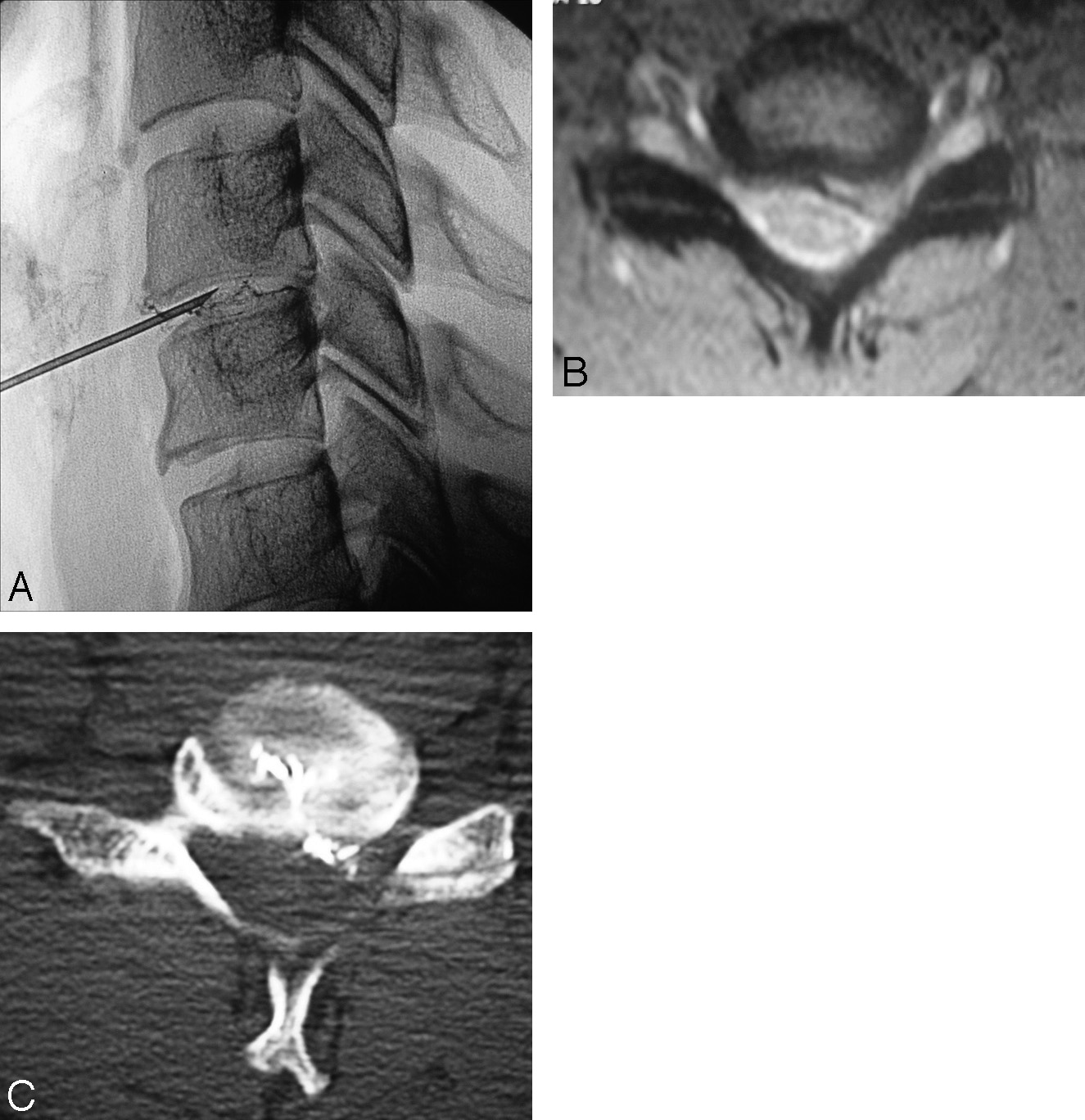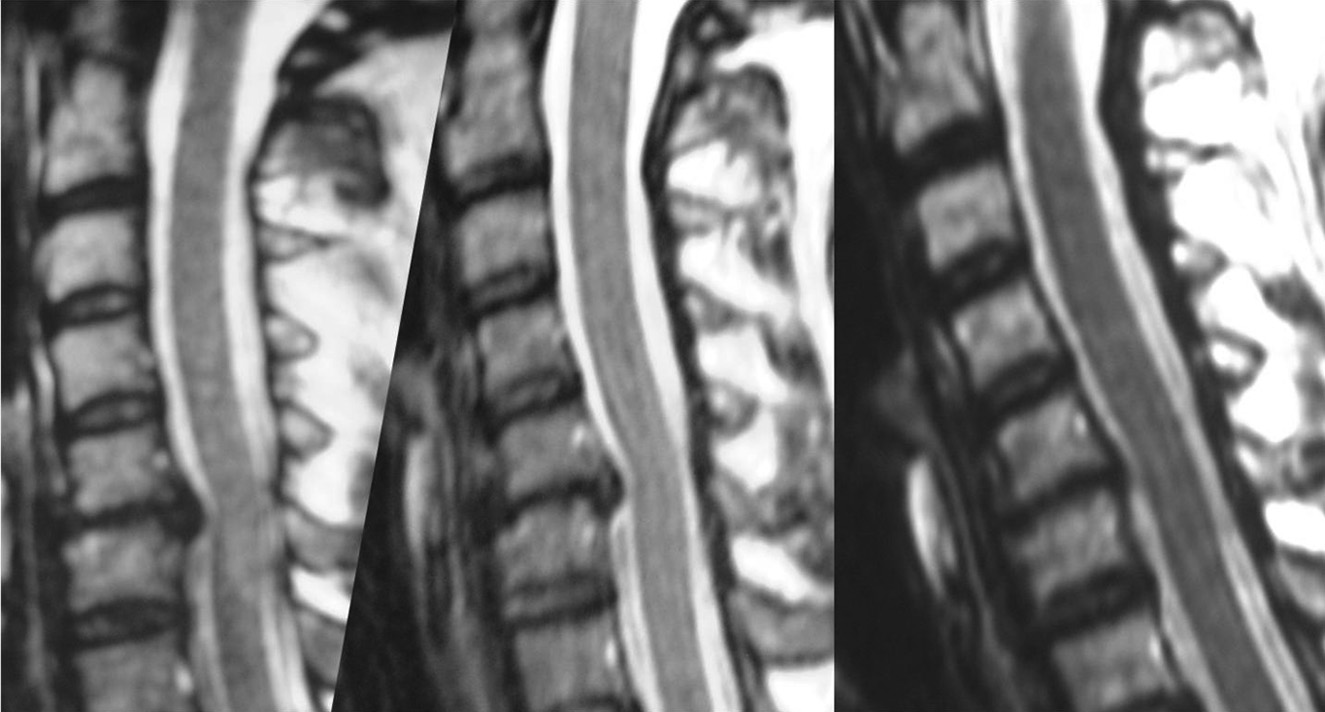Discogel.com.ar
Published January 6, 2010 as 10.3174/ajnr.A1923
Percutaneous Treatment of Cervical Disk Hernias
Using Gelified Ethanol
SUMMARY: This study investigates the efficacy of chemonucleolysis using RGE in the treatment of
cervical disk hernias in a small sample of patients who had cervical diskogenic or radicular painsecondary to disk herniations. Results were satisfactory in 89.5% patients, with no adverse events
recorded during the procedure or after. The use of RGE shows promising results and might be a
feasible and safe alternative in the treatment of cervical disk hernias.
ABBREVIATIONS: CHU ⫽ Centre Hospitalier Universitaire; IDH ⫽ intervertebral disk hernias; RGE ⫽
radiopaque gelified ethanol
Chemonucleolysis is an efficient technique for the treat- thepatientsupinewitharightanterolateralapproach.Afterthetreat-
ment of back pain; it consists of a percutaneous intradiskal
ment of the disk, we performed a concomitant injection of intra-
injection that dissolves the nucleus pulposus and lowers in-
articular steroids in the adjacent facet joints in all patients.9
tradiskal pressure. Several years ago, the most widely used sub-
Procedures were performed with local anesthetic, under surgical
stance for this was chymopapain, which had an efficacy of
conditions and controlled digital fluoroscopy. A diskography was
close to 80% in lumbar disk herniations and close to 85% in
performed before RGE nucleolysis. The dose of RGE injected into the
cervical disk hernias1-3 but was withdrawn from the market
cervical disk was 0.2– 0.3 mL. Intradiskal injection of 1–2 mg of gen-
due, in part, to anaphylactic reactions to this enzyme.4 After
tamicin was systematically performed in all the cases at the end of the
this, the search for a new drug that could have the same effi-
procedure to prevent infection. At least 1 facet joint at the level treated
cacy as chymopapain but without the complications led to the
was injected with 10 mg of intra-articular triamcinolone acetonide to
use of pure ethanol5 for chemonucleolysis with very good re-
help reduce inflammation. In case of bilateral symptoms, the injec-
sults and no allergic complications. The problem with pure
tion was performed in both facet joints (10 mg each). The level or
ethanol was the high diffusibility of the liquid, which some-
levels for treatment were chosen according to the patient's symptoms,
times led to radicular burning pain after the procedure and,
MR imaging findings if they were concordant, or a positive provoca-
more important, to epidural leaks, which could be severe es-
tion test performed during diskography.
pecially at the cervical level, where the spinal cord is closer to
All patients underwent thin-section CT of the treated level, per-
formed 3 hours after injection to evaluate the distribution and possi-
In treating venous angiomas, we had experience in using
ble leaks. Patients were left on anti-inflammatory drugs until the fol-
gelified pure ethanol, which had the same properties as liquid
low-up consultation at 15 days. Medical treatment was eventually
ethanol but could be better controlled at the time of injection
modified, depending on the residual symptoms. All patients were
and did not diffuse away from the site of injection.6,7 We pre-
seen in consultation again 6 weeks after treatment.
viously published our experience with a similar radiopaque
Fifty-seven patients were treated by using chemonucleolysis with
substance in the treatment of lumbar IDH with good results
RGE between 2004 and 2008; 89.5% reported important reduction or
and no complications.8 In this study, we investigate the poten-
disappearance of their symptoms at the first clinical consultation and
tial efficacy of this substance in cervical disk hernias.
no adverse events of any kind have been recorded during or after theprocedure.
Technique
RGE is a mixture of pure ethanol and a thickening substance with
tungsten powder. To investigate the efficacy of RGE, we set up a pro-
The main goal of percutaneous interventional techniques for
spective preliminary study. Approval of the ethics committee of the
the treatment of disk hernias is to reduce the hyperpressure
hospital was obtained. Patients sent to be treated for a cervical IDH
inside the disk and the hernia that compresses the nerve root
percutaneously, who had cervical diskogenic or radicular pain that
and also to reduce inflammation produced by annular tears or
did not resolve after the use of conventional therapy, were offered this
even by disk degeneration alone, which can be responsible for
alternative. An informed consent was obtained.
pain.9-11 Replacement techniques were sought by using de-
For treatment purposes, we kept the basis of our original thera-
compressive intradiskal techniques based on physical pro-
peutic concept used for many years: To reach the disk, we positioned
cesses such as disk vaporization in nucleoplasty with radio-frequency, electrothermal therapy, or mechanical reduction of
Received May 21, 2009; accepted after revision September 12.
the disk pressure by manual or automated percutaneous dis-
From the Department of Neuroradiologie (J.T., P.C.), CHU Coˆte de Nacre, Caen, France;
kectomy.12-15 All of them are somewhat effective but more
Clínica Nuestra Sen˜ora del Rosario (H.C., L.G., A.C.), Terapeutica Endovascular y Percuta-
expensive and time-consuming than chemonucleolysis.
nea, Madrid, Spain; and Department of Therapeutic Neuroangiography (L.G., T.S.), Hospital
Our initial experience with RGE at the cervical level has
General de Catalonia, Sant Cugat del Valles, Spain.
shown very promising results for the treatment of cervical
Please address correspondence to Jacques Theron, MD, Department of Neuroradiologie,
IDH, with improvement in symptoms in 89.5% of patients,
CHU Coˆte de Nacre, Ave de la Coˆte de Nacre, Caen, France 14000; e-mail:
[email protected]
results similar to those published for chymopapain16,17 and for
DOI 10.3174/ajnr.A1923
ozone,18 and without allergic complications. The injection of
AJNR Am J Neuroradiol : 兩 2010 兩 www.ajnr.org
Copyright 2010 by American Society of Neuroradiology.


Fig 1. Cervical disk hernia. A, Lateral fluoroscopy during injection of radiopaque gelified ethanol. B, MR image obtained before treatment. C, CT scan obtained after treatment showing
the radiopaque gel following the fissure of the disk and penetrating the extruded fragment.
Fig 2. A, MR image before treatment in a patient with cervical and radicular pain and a C5-C6 disk hernia. B, MR image 6 weeks after treatment with minimal change in the morphology
of the hernia, but the patient is clinically asymptomatic. C, MR image 4 years after treatment shows complete disappearance of the disk hernia. The patient remains asymptomatic.
RGE was adequately seen under fluoroscopy and was well dis-
tributed in the center of the disk and through the tears into
Although this was a small sample, we think that the therapeu-
the herniated portion without any epidural leaks; this last ef-
tic efficacy of RGE at the cervical level is promising and with-
fect was corroborated on disko-CT performed after the pro-
out complications related to the procedure so far. In the fu-
cedure (Fig 1). The results we obtained are similar to ones
ture, with larger samples and more controlled studies, it might
previously published for lumbar IDH.8 This similarity makes
be an alternative in the treatment of cervical IDH, considering
this technique and the use of RGE a potential alternative for
that therapeutic solutions respecting the integrity of the spine
patients with pain secondary to disk pathology at the cervical
should be preferred to treat disk hernias when conventional
level (Fig 2).
treatment has failed.
Theron 兩 AJNR 兩 2010 兩 www.ajnr.org
Connors JJ, Wojak, JC, eds. Interventional Neuroradiology: Strategies and Prac-
1. Gogan WJ, Fraser RD. Chymopapain: a 10-year, double-blind study. Spine
tical Techniques. Philadelphia: W.B. Saunders; 1999:424 –30
10. Freemont AJ. The cellular pathobiology of the degenerate intervertebral disc
(Phila Pa 1976) 1992;17:388 –94
and discogenic back pain. Rheumatology (Oxford) 2009;48:5–10
2. Krause D, Drape JL, Jambon F, et al. Cervical nucleolysis: indications, tech-
11. Peng B, Wu W, Hou S, et al. The pathogenesis of discogenic low back pain.
nique, results—190 patients. J Neuroradiol 1993;20:42–59
J Bone Joint Surg Br 2005;87:62– 67
3. Theron J, Blais M, Casasco A, et al. Therapeutic radiology of the lumbar spine:
12. Birnbaum K. Percutaneous cervical disc decompression. Surg Radiol Anat
disk chemonucleolysis, infiltration, and coagulation of posterior articula-
2009;31:379 – 87. Epub 2009 Feb 4
tions. J Neuroradiol 1983;10:209 –30
13. Freeman BJ, Mehdian R. Intradiscal electrothermal therapy, percutaneous
4. Hall BB, McCulloch JA. Anaphylactic reactions following the intradiscal in-
discectomy, and nucleoplasty: what is the current evidence? Curr Pain Head-
jection of chymopapain under local anesthesia. J Bone Joint Surg Am
ache Rep 2008;12:14 –21
14. Onik G, Maroon J, Helms C, et al. Automated percutaneous diskectomy: initial
5. Riquelme C, Musacchio M, Mont'Alverne F, et al. Chemonucleolysis of lumbar
patient experience—work in progress. Radiology 1987;162:129 –32
disc herniation with ethanol. J Neuroradiol 2001;28:219 –29
15. Theron J, Huet H, Coskun O. Cervical automated discectomy: report of 150
6. Sannier K, Dompmartin A, Theron J, et al. A new sclerosing agent in the treat-
cases and evolution in the management of failure cases. Interventional Neuro-
ment of venous malformations: study on 23 cases. Interventional Neuroradiol-
radiology 1996;2:35– 44
16. Gomez-Castresana F, Vazquez Herrero C, Baltes Horche JL, et al. Cervical chy-
7. Tiret I, Hecquard C, Leroyer R, et al. Formulation of a sclerosing ethylcellulose
mopapain nucleolysis: MR imaging assessment of chymopapain efficacy.
alcoholic gel in the treatment of venous malformations. J Pharm Clin
Neurosurg Clin N Am 1996;7:1–16
17. Krause D, Grafe JL, Maithor D, et al. Cervical chymopapain chemonucleolysis.
8. Theron J, Guimaraens L, Casasco A, et al. Percutaneous treatment of lumbar
Semin Musculoskelet Radiol 1997;1:207–14
intervertebral disk hernias with radiopaque gelified ethanol: a preliminary
18. Alexandre A, Coro L, Azuelos A, et al. Intradiscal injection of oxygen-ozone gas
study. J Spinal Disord Tech 2007;20:526 –32
mixture for the treatment of cervical disc herniations. Acta Neurochir Suppl
9. Theron J. Percutaneous treatment of cervical and lumbar disc herniations. In:
2005;92:79 – 82
AJNR Am J Neuroradiol : 兩 2010 兩 www.ajnr.org
Source: http://www.discogel.com.ar/ajnr_A1923v1.pdf
PhD Candidate, Dept. of Geography, University of Cambridge Email - [email protected] Research: My main focus is regional economic development. I am particularly interested in university-industry relationships and their influence on local economies. From Ivory Tower to Industrial Promotion: The Case of Yale University and the Biotechnology
Medical Progress and treatment. Small-vessel vasculitis is defined asvasculitis that affects vessels smaller than arteries,such as arterioles, venules, and capillaries. Importantcategories of the disease are listed in Table 1. It is important to note that small-vessel vasculitis some-times, but not always, also affects arteries, and thus the vascular distribution overlaps with that of the





